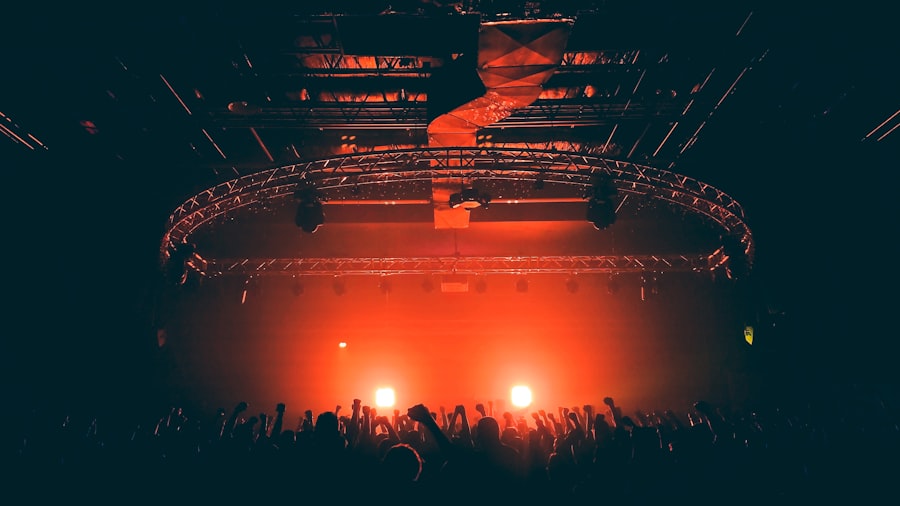Nigeria’s music scene has emerged as a vibrant and influential force on the global stage, characterized by its rich diversity and cultural depth. The marketing of music in Nigeria is not merely a business endeavor; it is a dynamic interplay of creativity, technology, and cultural expression. As the country continues to produce globally recognized artists and genres, such as Afrobeats, hip-hop, and highlife, the strategies employed to market this music have evolved significantly.
The rise of digital platforms has transformed how artists reach their audiences, making it essential for musicians and marketers alike to understand the nuances of this rapidly changing landscape. In recent years, the Nigerian music industry has witnessed an unprecedented surge in popularity, both locally and internationally. This growth has been fueled by a combination of factors, including the proliferation of streaming services, social media engagement, and the increasing presence of Nigerian artists on global charts.
As a result, effective music marketing strategies have become crucial for artists seeking to carve out their niche in this competitive environment. Understanding the intricacies of Nigeria’s music marketing landscape is vital for artists, producers, and marketers who aim to harness the full potential of this thriving industry.
Key Takeaways
- Nigeria has a vibrant and diverse music industry with a rich cultural heritage that influences its marketing strategies.
- Social media is a powerful tool for promoting music in Nigeria, with platforms like Instagram and Twitter being popular among the youth.
- Collaborating with influencers and brands can help Nigerian musicians reach a wider audience and gain credibility in the industry.
- Traditional media, such as radio and TV, still play a significant role in music promotion in Nigeria and should not be overlooked.
- Building a strong online presence and engaging with fans is crucial for success in Nigeria’s music market, where competition is fierce.
Understanding the Nigerian Music Industry
The Nigerian Music Industry: A Complex Ecosystem
The Nigerian music industry is a multifaceted and dynamic ecosystem that encompasses a wide range of genres, styles, and cultural influences. It is characterized by its unique blend of traditional sounds and contemporary trends, which together create a rich tapestry of musical expression. The industry is not only a source of entertainment but also a significant contributor to the country’s economy, providing jobs and opportunities for countless individuals involved in various aspects of music production, distribution, and promotion.
Diversity and Cultural Significance
From record labels to independent artists, the industry is marked by a diverse array of players who contribute to its vibrancy. Moreover, the Nigerian music industry is heavily influenced by its cultural context. Music serves as a reflection of societal values, struggles, and aspirations, making it an essential medium for storytelling and communication.
Global Appeal and Innovative Marketing Strategies
The rise of genres like Afrobeats has not only captured the attention of local audiences but has also resonated with listeners around the world. This global appeal has prompted many artists to explore innovative marketing strategies that leverage both traditional and digital platforms. Understanding the cultural significance of music in Nigeria is crucial for anyone looking to navigate this multifaceted industry effectively.
Leveraging Social Media for Music Promotion

In today’s digital age, social media has become an indispensable tool for music promotion in Nigeria. Platforms such as Instagram, Twitter, TikTok, and Facebook provide artists with direct access to their audience, allowing them to share their music, engage with fans, and build their brand identity. The immediacy and interactivity of social media enable artists to create buzz around new releases, share behind-the-scenes content, and connect with fans on a personal level.
This direct engagement fosters a sense of community and loyalty among listeners, which can significantly enhance an artist’s visibility and reach. Furthermore, social media allows for innovative marketing campaigns that can go viral in an instant. Artists can collaborate with content creators and influencers to amplify their message and reach wider audiences.
For instance, challenges on TikTok or dance trends associated with a new song can lead to organic promotion that transcends traditional marketing methods. By harnessing the power of social media effectively, Nigerian artists can not only promote their music but also shape their public persona and establish themselves as influential figures within the industry.
Collaborating with Influencers and Brands
| Metrics | 2019 | 2020 | 2021 |
|---|---|---|---|
| Number of influencer collaborations | 50 | 75 | 100 |
| Brand partnerships | 10 | 15 | 20 |
| Engagement rate | 3% | 4% | 5% |
Collaboration has become a cornerstone of successful music marketing in Nigeria. By partnering with influencers and brands that align with their artistic vision, musicians can tap into new audiences and enhance their credibility. Influencers possess established followings that trust their recommendations; thus, when they endorse an artist or a song, it can lead to increased visibility and engagement.
This symbiotic relationship benefits both parties: artists gain exposure while influencers enrich their content with fresh musical talent. Moreover, brand collaborations can provide financial support and resources that are essential for effective marketing campaigns. Many brands are eager to associate themselves with popular musicians to reach younger demographics who are often more engaged with music than traditional advertising methods.
For instance, partnerships between artists and beverage companies or fashion brands can result in co-branded events or promotional campaigns that resonate with fans. These collaborations not only enhance an artist’s marketability but also create memorable experiences for fans that deepen their connection to the music.
Utilizing Traditional Media for Music Promotion
While digital platforms dominate the current landscape of music marketing in Nigeria, traditional media still plays a vital role in promoting artists and their work. Radio stations remain influential in shaping public taste and introducing new music to listeners across the country. Many Nigerians rely on radio as their primary source of entertainment and information; thus, securing airplay can significantly boost an artist’s profile.
Engaging with radio DJs and producers to ensure that new tracks receive adequate airtime is a crucial strategy for any artist looking to expand their reach. Television also continues to be an important medium for music promotion in Nigeria. Music videos broadcast on popular channels can capture the attention of viewers who may not be active on social media or streaming platforms.
Additionally, appearances on talk shows or music programs provide artists with opportunities to showcase their personalities and connect with audiences on a deeper level. By leveraging both traditional media outlets alongside digital strategies, artists can create a comprehensive marketing approach that maximizes their chances of success in a competitive industry.
Developing a Strong Online Presence

Establishing a Strong Online Presence
In today’s digital age, having a strong online presence is crucial for artists seeking success in Nigeria’s music industry. This involves more than just having active social media profiles; it also requires a professional website that serves as a central hub for all aspects of an artist’s career. A well-designed website can effectively showcase an artist’s discography, upcoming events, merchandise, and press coverage, while providing fans with easy access to their music across various streaming platforms.
Consistency and Engagement
Consistency is key to maintaining a strong online presence. Regularly updating content, whether through new music releases, engaging social media posts, or blog entries, keeps fans interested and invested in an artist’s journey. This helps build a loyal fan base that supports the artist’s work both online and offline.
Optimizing Online Visibility
Utilizing search engine optimization (SEO) techniques can significantly increase an artist’s visibility on search engines, making it easier for potential fans to discover new music. By prioritizing SEO, artists can expand their online reach and attract new listeners.
Cultivating a Loyal Fan Base
By prioritizing a robust online presence, artists can cultivate a loyal fan base that supports their work both online and offline. This not only helps artists build a successful music career but also fosters a sense of community and connection with their fans.
Engaging with Fans and Building a Community
Engagement with fans is at the heart of successful music marketing in Nigeria. Artists who take the time to interact with their audience—whether through social media comments, live Q&A sessions, or fan meet-and-greets—create a sense of belonging among their supporters. This personal connection fosters loyalty and encourages fans to advocate for the artist within their own networks.
Building a community around an artist’s brand not only enhances fan engagement but also creates opportunities for collaborative projects that can further elevate an artist’s profile. Additionally, creating exclusive content for fans can deepen this sense of community. Offering behind-the-scenes glimpses into the creative process or sharing personal stories can make fans feel more connected to the artist’s journey.
Furthermore, hosting contests or giveaways can incentivize fan participation while generating excitement around new releases or events. By prioritizing fan engagement and community building, artists can cultivate a supportive network that contributes to their long-term success in the industry.
Navigating the Challenges of Nigeria Music Marketing
Despite its vibrant potential, navigating the challenges of music marketing in Nigeria requires resilience and adaptability. One significant hurdle is the issue of piracy, which remains prevalent in the country. Unauthorized distribution of music not only undermines artists’ revenue but also complicates efforts to build a sustainable career in the industry.
To combat this challenge, artists must be proactive in educating their audience about the importance of supporting legitimate channels for music consumption while exploring innovative ways to monetize their work through live performances and merchandise sales. Another challenge lies in the saturation of the market due to the influx of new talent seeking recognition. With so many artists vying for attention, standing out becomes increasingly difficult.
To overcome this obstacle, musicians must develop unique branding strategies that highlight their individuality while remaining authentic to their artistic vision. This may involve experimenting with different sounds or collaborating with diverse artists to create fresh content that resonates with audiences. By embracing these challenges as opportunities for growth and innovation, Nigerian artists can navigate the complexities of music marketing while carving out their own space within this dynamic industry.
If you’re interested in learning more about the intricacies of music marketing in Nigeria, I recommend checking out an insightful article on Music Promotion Tech. This website offers a wealth of resources and expert advice tailored specifically to the needs of artists looking to navigate the vibrant and diverse Nigerian music scene. Whether you’re a seasoned musician or just starting out, this site can provide valuable guidance on how to effectively promote your music and reach a wider audience.
FAQs
What is music marketing in Nigeria?
Music marketing in Nigeria refers to the process of promoting and selling music produced by Nigerian artists. It involves various strategies such as digital marketing, social media promotion, radio and TV airplay, and live performances to reach a wider audience and generate revenue.
What are the key components of music marketing in Nigeria?
Key components of music marketing in Nigeria include digital distribution, social media promotion, public relations, radio and TV airplay, live performances, and collaborations with other artists and brands.
How do Nigerian artists promote their music?
Nigerian artists promote their music through various channels such as social media platforms (e.g., Instagram, Twitter, and YouTube), music streaming services, radio and TV interviews, live performances, and collaborations with other artists and influencers.
What are the challenges of music marketing in Nigeria?
Challenges of music marketing in Nigeria include piracy, lack of proper infrastructure for music distribution, limited access to international markets, and the need for more effective copyright protection and royalty collection systems.
How important is digital marketing in the Nigerian music industry?
Digital marketing is crucial in the Nigerian music industry as it allows artists to reach a global audience, build a fan base, and generate revenue through online music sales, streaming, and digital content creation.
What role do music labels and distribution companies play in Nigeria’s music marketing?
Music labels and distribution companies in Nigeria play a significant role in marketing and promoting artists’ music by providing resources, expertise, and connections to reach a wider audience, secure collaborations, and negotiate deals with brands and media outlets.


























